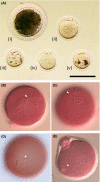Assisted reproductive technologies in Microtus genus
- PMID: 30996675
- PMCID: PMC6452009
- DOI: 10.1002/rmb2.12244
Assisted reproductive technologies in Microtus genus
Abstract
Background: Microtus genus is one of the experimental animals showing unique characteristics, and some species have been used as various research models. In order to advance the utilization of Microtus genus, the development of assisted reproductive technologies (ARTs) is a key point. This review introduces recent progress in the development of ARTs for Microtus genus, especially Microtus montebelli (Japanese field vole).
Methods: Based on previous and our publications, current status of the development of ARTs was summarized.
Results: In M. montebelli, ARTs, such as superovulation, in vitro fertilization, intracytoplasmic sperm injection, embryo transfer, sperm cryopreservation, and nonsurgical artificial insemination, have considerably been established by using the procedures which were originally devised for mice and partly modified. However, when the methods for M. montebelli were applied to Microtus arvalis and Microtus rossiaemeridionalis, all protocols of ARTs except for sperm cryopreservation were technologically invalid.
Conclusion: Assisted reproductive technologies (ARTs) are considerably established in M. montebelli, and this fact allows this species to be potentially useful as a model animal. However, since ART protocols of M. montebelli are mostly invalid for other species of the Microtus genus, it is necessary to improve them specifically for each of other species.
Keywords: Microtus montebelli; assisted reproductive technology; gamete; herbivorous rodent; vole.
Conflict of interest statement
Conflict of interest: The author declares no conflict of interest. Human studies: This article does not contain any studies with human participants performed by the author. An animal use ethics statement: The designed animal experimental protocol was approved by the Animal Experimental Committee of Nippon Veterinary and Life Science University. All procedures were complied with guideline for Proper Conduct of Animal Experimental by Science Council of Japan. All animals were humanely treated throughout the course of experiments, and maximum care was taken to minimize pain of experimental animals.
Figures



Similar articles
-
Improvement of nonsurgical artificial insemination with cryopreserved spermatozoa in Alexandromys montebelli, Japanese grass vole.Anim Sci J. 2024 Jan-Dec;95(1):e13990. doi: 10.1111/asj.13990. Anim Sci J. 2024. PMID: 39246221
-
[Breeding and rearing of Japanese field voles (Microtus montebelli Milne-Edwards) and Hungarian voles (Microtus arvalis Pallas) as new herbivorous laboratory animal species].Jikken Dobutsu. 1982 Jul;31(3):175-83. doi: 10.1538/expanim1978.31.3_175. Jikken Dobutsu. 1982. PMID: 6754391 Japanese.
-
Establishment of superovulation procedure in Japanese field vole, Microtus montebelli.Theriogenology. 2016 Aug;86(3):899-905. doi: 10.1016/j.theriogenology.2016.03.012. Epub 2016 Mar 19. Theriogenology. 2016. PMID: 27118387
-
Development of assisted reproductive technologies in small animal species for their efficient preservation and production.J Reprod Dev. 2020 Aug 20;66(4):299-306. doi: 10.1262/jrd.2020-033. Epub 2020 Apr 19. J Reprod Dev. 2020. PMID: 32307339 Free PMC article. Review.
-
Microtus species as new herbivorous laboratory animals: reproduction; bacterial flora and fermentation in the digestive tracts; and nutritional physiology.Vet Res Commun. 1984 May;8(2):77-91. doi: 10.1007/BF02214700. Vet Res Commun. 1984. PMID: 6377675 Review.
References
-
- Hoffmann H, Hilton‐Taylor C, Angulo A et al. The impact of conservation on the status of the world's vertebrates. Science. 2010;330:1503‐1509. - PubMed
-
- Small E. The new Noah’s Ark: beautiful and useful species only. Part 1. Biodiversity conservation issues and priorities. Biodiversity. 2012;13:121‐16.
-
- Small E. The new Noah’s Ark: beautiful and useful species only. Part 2. The chosen species. Biodiversity. 2012;13:37‐53.
-
- The International Union for Conservation of Nature; IUCN, RED LIST (2018–1). - PubMed
-
- Kawamura R, Ikeda K. Ecological study of the Microtus montebelli on field causing Tsutsugamushi, Trombicula akamushi (BRUMPT). Doubutsugaku zasshi. 1935;47:90‐101.
Publication types
LinkOut - more resources
Full Text Sources
